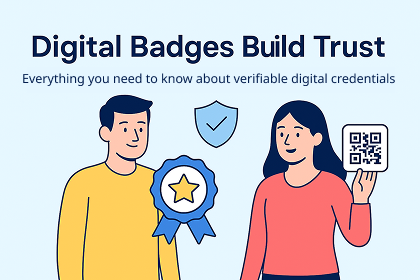No user accounts required for your recipients -
Existing certificates and badges always stay valid


Everything you need to know about verifiable digital credentials and why they matter



A digital badge is a visual representation of a skill, achievement, or credential that is issued, stored, and shared online. Unlike static PDF certificates, digital badges are interactive, verifiable, and dynamic – giving them far more weight when it comes to building trust with learners, employers, and the public.
But why is trust so critical right now?
Because education and professional development are increasingly decentralized. Online courses, short-term training programs, and workshops are on the rise – and with them, the risk of unverified or even fake credentials. Without a clear way to confirm authenticity, certificates lose value.
Digital badges address this issue head-on. They are not just a design or a file – they are proof of learning that can be independently verified, in real-time.
🔗 Related: How to Protect Your Certificates from AI Fakes
Let’s clarify an important term: verifiable credentials. A digital badge is only trustworthy if it contains the right data and infrastructure to prove its authenticity – both to people and to systems.
Here are the three pillars of a verifiable credential:
These features create a level of transparency and security that traditional certificates simply can’t match.
PDF certificates used to be the gold standard for proving course completions or skills – but that era is over. In the age of generative AI and design tools, creating fake certificates has become alarmingly easy.
Tools like ChatGPT, Canva, or browser-based PDF editors make it possible to:
This means anyone can make themselves look “certified” – even if they’ve never completed the training.
And most employers or stakeholders won’t take the time to validate a PDF manually. They either trust the document – or ignore it.
Digital badges solve this problem. Every verifiable badge includes a built-in truth check. Anyone clicking on a badge or scanning its QR code is instantly redirected to the validation page – making fake credentials practically useless.
Trust is the foundation of any learning ecosystem. But beyond authenticity, digital badges offer an unexpected bonus: they become powerful brand ambassadors.
When learners share their verified achievements online, they’re not only showcasing their skills – they’re also amplifying your institution’s visibility.
Here’s how digital badges contribute to both trust and brand impact:
📣 LinkedIn Visibility
Every verifiable badge can be added to LinkedIn profiles, giving your brand long-term exposure in a professional context. The badge links back to a validation page with your name, your logo, and your course offering.
See more at our page for LinkedIn Badges
📈 SEO Benefits
Public badge validation pages are indexed by search engines. This means your organization can gain organic traffic from searches related to skills, credentials, or specific training programs.
🎯 Social Proof
When hundreds of learners display your digital credentials, it builds social credibility. Prospects don’t just read about your quality – they see it in action.
If you're wondering how to measure the ROI of digital badges, there's a dedicated approach. Learn more in this in-depth article: Digital Badges as a Marketing Tool
Digital badges are not just verification tools, they are living touchpoints between your brand and a wider audience.
Let’s look at how training providers and institutions apply verifiable credentials in practice – and what results they see.
Imagine a first aid training center that used to issue PDF certificates by email. Participants often forgot to download them. Some shared screenshots on social media, others never used them at all.
Since switching to digital badges, the impact has been measurable:
Another example comes from a university that introduced verifiable credentials for microlearning modules. Students can now showcase soft skills, project work, or certifications in leadership – each backed by a unique, tamper-proof badge.
These cases show: Digital badges don’t just protect your reputation – they enhance it.
They provide learners with a secure, modern, and respected way to represent their accomplishments.
Verifiable digital badges are not a trend – they are becoming the new standard in certification.
They offer what traditional credentials lack:
✔️ Immediate trust
✔️ Built-in verification
✔️ Brand visibility
Education providers, training centers, and institutions that embrace digital credentials gain more than just efficiency. They gain credibility in the eyes of learners, employers, and partners.
In a world where AI makes fakes easier than ever, you can no longer rely on documents that look official. You need credentials that prove they are.
Digital badges build trust – now it’s your move.
👉 Start issuing verifiable credentials with Virtualbadge.io and schedule a free demo
* You can find the organisation ID in the URL when you access your LinkedIn Company page as an admin.


Marketing
Aug 6, 2025
5 min
Use Virtualbadge.io to design and send digital certificates that create trust - in less than 10 minutes.